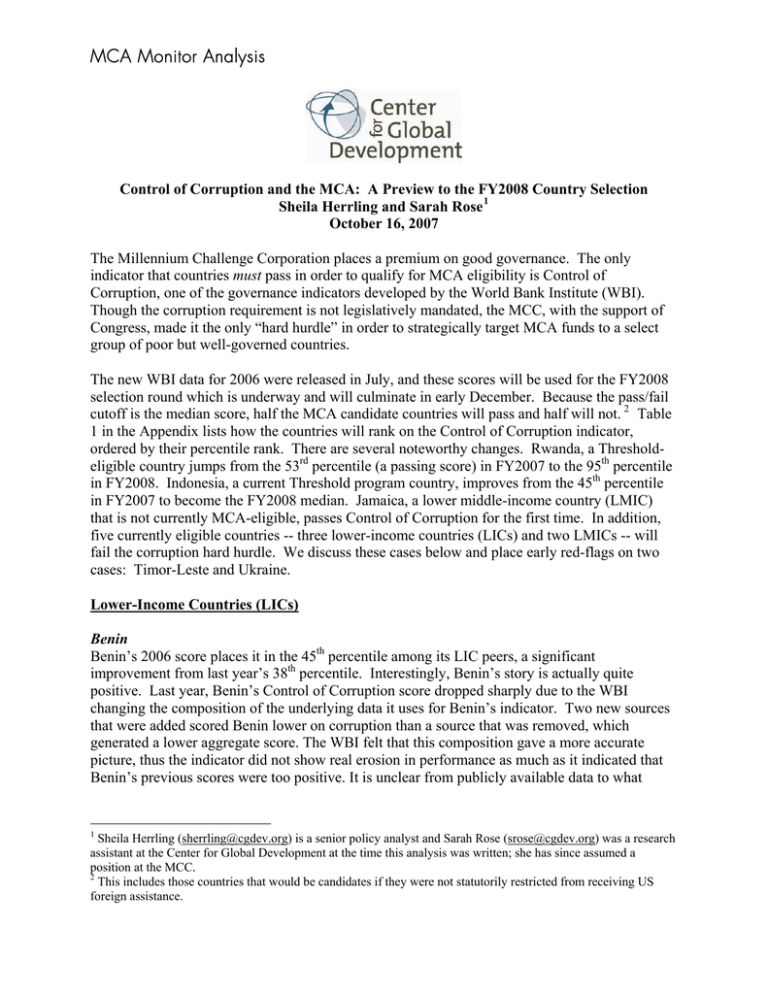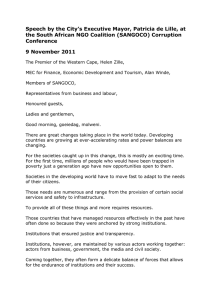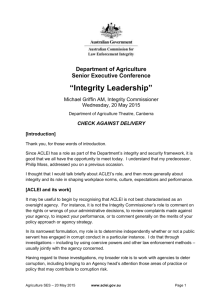MCA Monitor Analysis
advertisement

MCA Monitor Analysis Control of Corruption and the MCA: A Preview to the FY2008 Country Selection Sheila Herrling and Sarah Rose 1 October 16, 2007 The Millennium Challenge Corporation places a premium on good governance. The only indicator that countries must pass in order to qualify for MCA eligibility is Control of Corruption, one of the governance indicators developed by the World Bank Institute (WBI). Though the corruption requirement is not legislatively mandated, the MCC, with the support of Congress, made it the only “hard hurdle” in order to strategically target MCA funds to a select group of poor but well-governed countries. The new WBI data for 2006 were released in July, and these scores will be used for the FY2008 selection round which is underway and will culminate in early December. Because the pass/fail cutoff is the median score, half the MCA candidate countries will pass and half will not. 2 Table 1 in the Appendix lists how the countries will rank on the Control of Corruption indicator, ordered by their percentile rank. There are several noteworthy changes. Rwanda, a Thresholdeligible country jumps from the 53rd percentile (a passing score) in FY2007 to the 95th percentile in FY2008. Indonesia, a current Threshold program country, improves from the 45th percentile in FY2007 to become the FY2008 median. Jamaica, a lower middle-income country (LMIC) that is not currently MCA-eligible, passes Control of Corruption for the first time. In addition, five currently eligible countries -- three lower-income countries (LICs) and two LMICs -- will fail the corruption hard hurdle. We discuss these cases below and place early red-flags on two cases: Timor-Leste and Ukraine. Lower-Income Countries (LICs) Benin Benin’s 2006 score places it in the 45th percentile among its LIC peers, a significant improvement from last year’s 38th percentile. Interestingly, Benin’s story is actually quite positive. Last year, Benin’s Control of Corruption score dropped sharply due to the WBI changing the composition of the underlying data it uses for Benin’s indicator. Two new sources that were added scored Benin lower on corruption than a source that was removed, which generated a lower aggregate score. The WBI felt that this composition gave a more accurate picture, thus the indicator did not show real erosion in performance as much as it indicated that Benin’s previous scores were too positive. It is unclear from publicly available data to what 1 Sheila Herrling (sherrling@cgdev.org) is a senior policy analyst and Sarah Rose (srose@cgdev.org) was a research assistant at the Center for Global Development at the time this analysis was written; she has since assumed a position at the MCC. 2 This includes those countries that would be candidates if they were not statutorily restricted from receiving US foreign assistance. MCA Monitor Analysis degree the 2006 improvement is attributable to policy change, change in perceptions, or the three new sub-sources that were added, but anti-corruption efforts in Benin appear to be improving. Honduras Honduras will fail Control of Corruption by a narrow margin this year, coming out in the 47th percentile. After a steady improvement in controlling corruption since 2002, the 2006 score drops off somewhat. It is extremely unlikely that Honduras’ failure to pass Control of Corruption this year will challenge its eligibility or continued compact participation for two reasons: (i) the potential for measurement error inherent in the indicators—a score in the 47th percentile is too close to the median to definitively say that the true measure of corruption in a country is in fact below the 50th percentile; and (ii) Honduras showed no change in score from last year in Transparency International’s 2007 Corruption Perceptions Index (CPI), a supplemental source used by MCC. 3 That said, it will be important to track Honduras’ anticorruption efforts to see if a continued downward trend emerges. Timor-Leste Timor-Leste’s Control of Corruption score declines for the second year in a row. It just passed the LIC median last year, and this year falls to the 43rd percentile. As in the case of Honduras, Timor-Leste shows no change in score from last year in Transparency International’s 2007 CPI (indeed, it ranks in the 53rd percentile) and its score is close enough to the median to not be able to discard measurement error as a contributor to the failing score (although to a lesser degree). Still, with two declines in a row, MCC will need to pay attention to corruption in Timor-Leste and monitor closely future changes. Lower Middle-Income Countries (LMICs) Armenia Armenia moves up in income category this year to become an LMIC, so it faces higher medians. Though Armenia fails Control of Corruption in the LMIC category, its raw score 4 would have been sufficient to pass in the LIC category had it stayed, and its 2006 score is an improvement over both its 2004 and 2005 scores. So while Armenia does not pass the LMIC hurdle, the picture painted does not appear to be one of policy deterioration. Ukraine Ukraine, like Armenia, moves from LIC status to LMIC status in FY2008. It, too, would have passed the corruption hurdle in the LIC category, but it fails the LMIC category’s higher median. Its 2006 score is a slight drop in absolute terms from 2005, although it is still an improvement over all scores from 2004 and earlier. This decline may reflect a change in indicator composition if the newly added Gallup World Poll evaluates Ukraine less favorably than some other institutions. Ukraine also registered a series of declines on various sub-component indicators from Transparency International’s Global Corruption Barometer: in 2006, Ukrainian citizens perceived an increase in corruption in the Rada (the parliament), the judiciary, the police force, 3 There was a small downward shift in the confidence interval around the score in 2007. Honduras’ score remained at 2.5, but the confidence interval went from 2.4-2.7 in 2006 to 2.3-2.6 in 2007. 4 The MCC rescales the WBI’s raw scores to create a 0 median for each income group of countries (LICs and LMICs). Thus each country’s score is relative only to its income-level peers. MCA Monitor Analysis tax administration, registry and permit services, and public utilities; and the number of households reporting that they paid a bribe increased from 13% in 2005 to 23% in 2006. 5 It may also be attributable to actual declines in policy performance: according to Freedom House’s “Nations in Transit,” fighting corruption took a back seat to the 2006 parliamentary elections and the process of creating a new coalition government. This, along with a lack of parliamentary support for the president’s attempted initiatives to push through anticorruption legislation likely contributed to a reversion to higher corruption rates. 6 Through a Threshold Program the MCC is engaged with Ukraine on anticorruption efforts, in particular those that target judicial reform, the enforcement of anticorruption regulations and civil society monitoring. The MCC needs to closely track Ukraine’s performance on this program relative to expected results to inform any decisions related to proceeding with a compact. Threshold Programs and Corruption Thirteen of MCC’s 17 current Threshold Programs are designed to target corruption, so we took a look at those countries’ performance on the Control of Corruption indicator over time. Countries with threshold programs focusing on corruption 0.2 0 Control of Corruption score (WBI 2007) 1996 1997* 1998 1999* 2000 2001* 2002 2003 2004 2005 2006 -0.2 LMIC -0.4 -0.6 -0.8 LIC d -1 -1.2 -1.4 ALBANIA MOLDOVA UKRAINE 5 INDONESIA PARAGUAY YEMEN KENYA PHILIPPINES ZAMBIA KYRGYZSTAN TANZANIA LIC median FY2008 MALAWI UGANDA LMIC median FY2008 Transparency International. (2006). Report on the Transparency International Global Corruption Barometer 2006. Berlin: Transparency International. and Transparency International. (2005). Report on the Transparency International Global Corruption Barometer 2005. Berlin: Transparency International. 6 Sushko, Oleksander and Prystayko, Olena. (2007). Ukraine. In. Nations in Transit 2007. Budapest: Freedom House Europe. http://www.freedomhouse.hu//images/fdh_galleries/NIT2007final/nit-ukraine-web.pdf MCA Monitor Analysis * scores for 1997, 1999 and 2001 are imputed. Data were only reported every other year until 2002, so the datapoints for those three years are averages of the surrounding scores; they do not necessarily reflect a true snapshot of that time since the corruption indicator rarely proceeds in an even trajectory. Interestingly, what the data show is that almost all countries show an improvement in their Control of Corruption scores this year (all except the Philippines, Ukraine, and the Kyrgyz Republic). This is not to say that this is evidence of the Threshold Programs’ success. Many programs have not been underway long enough to show results, and even for those that have, it is extraordinarily hard to attribute an improvement in governance—particularly when defined as complexly as this indicator is—to any particular donor intervention. What it does appear to indicate, however, is that MCC is targeting its Threshold programs well. The MCC says its Threshold Program is designed for countries that “have not yet qualified for MCA Compact funding, but have demonstrated a significant commitment to improve their performance on the eligibility criteria for MCA Compact funding.” That most countries are showing improvements in their Control of Corruption score is a good indication of their commitment to improving their performance. MCA funding (and signaling of support) may thus be coming at a critical juncture of reform. MCA Monitor Analysis Appendix Table 1: FY2008 Control of Corruption rank LICs Country LMICs Control of Corruption Percentile Rank Country Cape Verde Control of Corruption Percentile Rank Bhutan 100% Vanuatu 99% Jordan 100% 97% Kiribati 97% Samoa 94% Lesotho 96% Tunisia 91% Rwanda 95% Namibia 88% Ghana 93% Morocco 84% Eritrea 92% Tuvalu 81% India 91% El Salvador 78% Madagascar 89% Suriname 75% Cuba 88% Colombia 72% Solomon Islands 86% Thailand 69% Sri Lanka 85% Micronesia 66% Georgia 84% Bosnia and Herzegovina 63% Tanzania 82% Fiji 59% Egypt 81% Peru 56% Senegal 80% Jamaica 53% Burkina Faso 78% Macedonia 50% Sao Tome and Principe 77% Algeria 47% Mongolia 76% Swaziland 44% Ethiopia 74% Maldives 41% Mali 73% Marshall Islands 38% Mozambique 72% China 34% Comoros 70% Armenia 31% Yemen 69% Dominican Republic 28% Mauritania 68% Iran 25% Guyana 66% Albania 22% Bolivia 65% Ukraine 19% Gambia 64% Guatemala 16% Moldova 62% Ecuador 13% Syria 61% Belarus 9% Vietnam 59% Azerbaijan 6% Djibouti 58% Angola 3% Philippines 57% Tonga 0% Uganda 55% Malawi 54% Nepal 53% Nicaragua 51% Indonesia 50% Zambia 49% Honduras 47% Benin 46% Liberia 45% MCA Monitor Analysis Timor-Leste 43% Tajikistan 42% Pakistan 41% Cameroon 39% Guinea 38% Niger 36% Kenya 35% Guinea-Bissau 34% Togo 32% Uzbekistan 31% Paraguay 30% Laos 28% Congo, Rep. 27% Central African Republic 26% Burundi 24% Kyrgyz Republic 23% Sudan 22% Papua New Guinea 20% Cote d'Ivoire 19% Chad 18% Cambodia 16% Sierra Leone 15% Turkmenistan 14% Nigeria 12% Bangladesh 11% Zimbabwe 9% Iraq 8% Congo, Dem. Rep. 7% Haiti 5% Afghanistan 4% Myanmar 3% Korea, Dem. Rep. 1% Somalia 0% Countries are with scores equal to or below the median fail the corruption indicator in FY2008 and are shaded.





